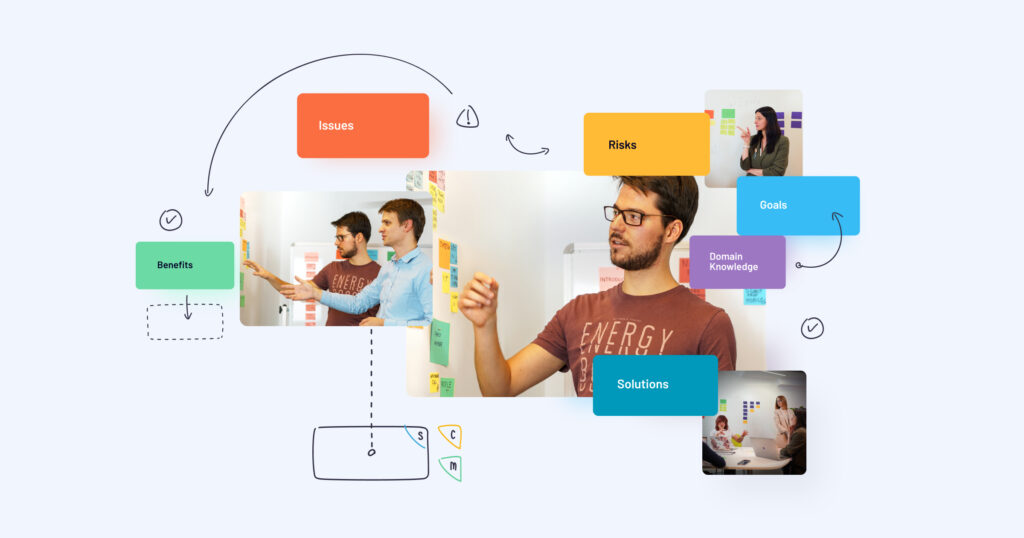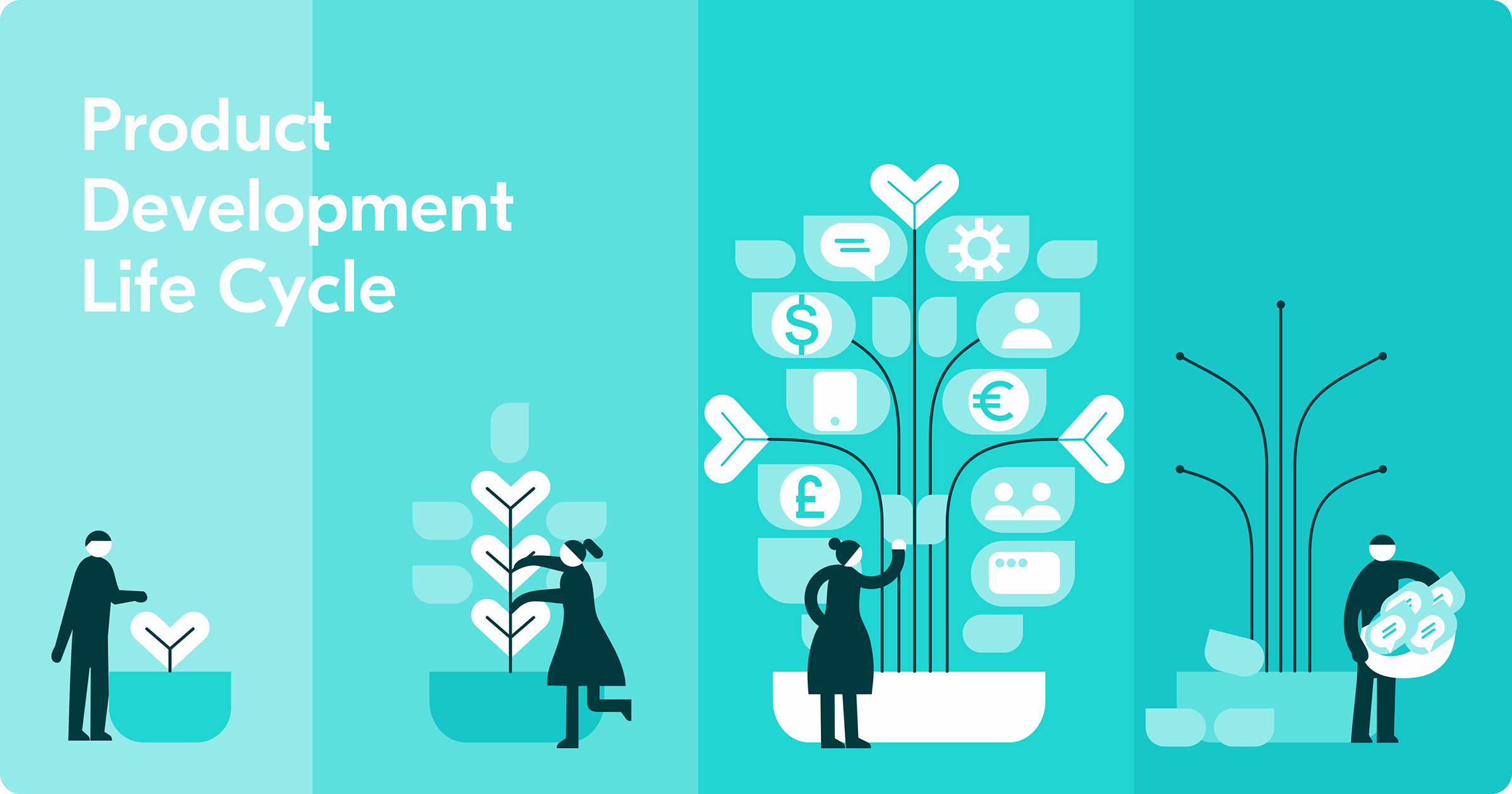
Although there’s no fine line between the stages, it’s easier to spot and deal with emergencies when you understand what to expect. And with a well thought out long-term product strategy, your trip will be more predictable, and you’ll be more prepared to everything that’s coming.
Milestones of a product’s life path
Usually, a product life cycle is divided into four discrete stages:
- The introductory stage when the product enters the market;
- The growth stage when it establishes its position and brings the most profit;
- The maturity stage when it stabilizes in the market and has the highest sales volumes;
- The decline stage.
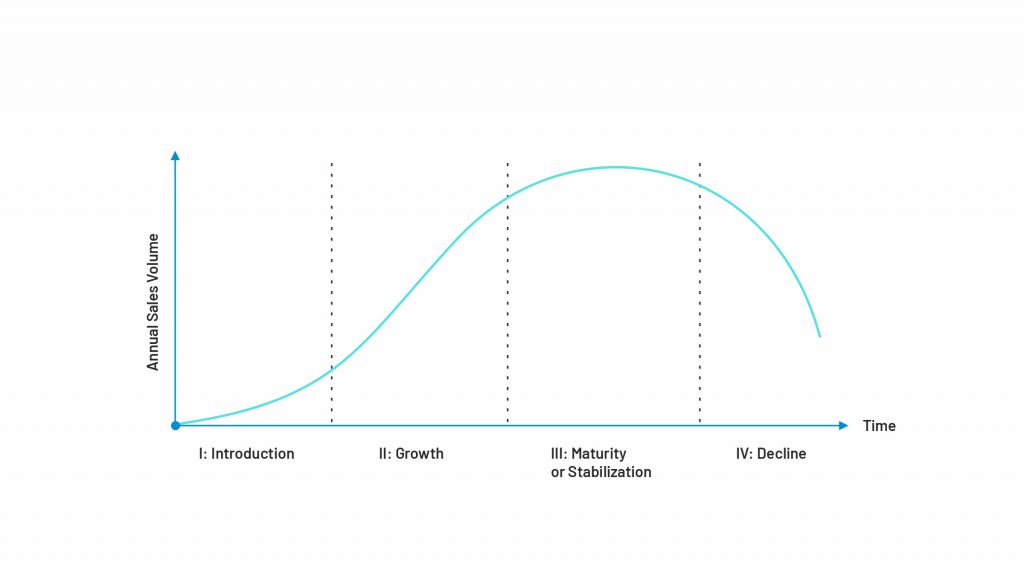
However, before a product appears in the market, it inevitably goes through a period of conceptual elaboration and engineering. Hence, the development stage should not be excluded from the life cycle. Besides, the decline stage also leads to several diverse scenarios, as not all the products exit the market through the same door. We will refer to this period as the afterlife stage. After adding two extra steps, the classic image of the product life cycle expands and starts to resemble the drawing of Exupéry’s hat from The Little Prince.
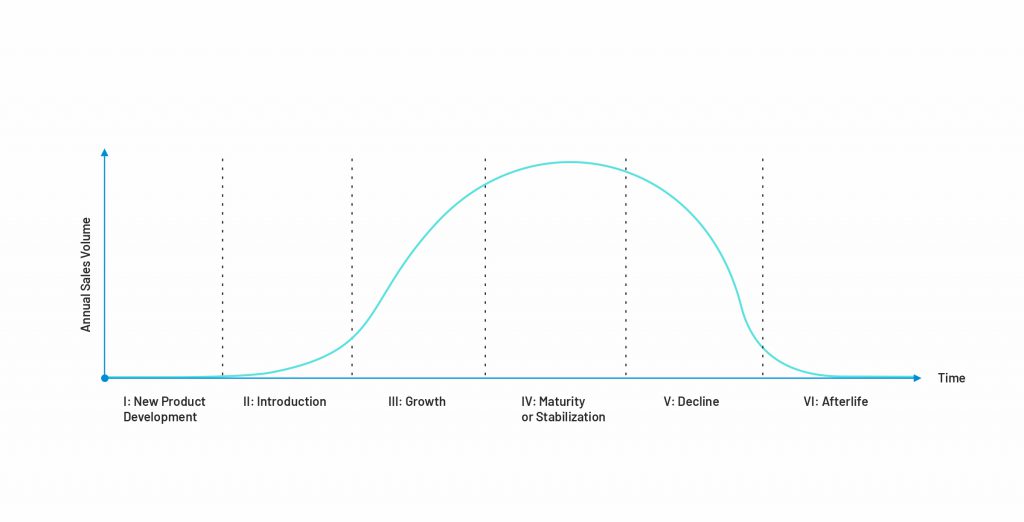
Each of these phases has vital characteristics and indicators for evaluation, a clear purpose, several connected goals to achieve, exit criteria, and conditions for the transition to the next stage. However, the transition from phase to phase does not occur overnight and does not have a distinct milestone to identify the end of one stage and the beginning of the next. Even though the borders separating phases are blurry, a general overview of each period will come in handy for an understanding of the path each product completes.
New product development stage
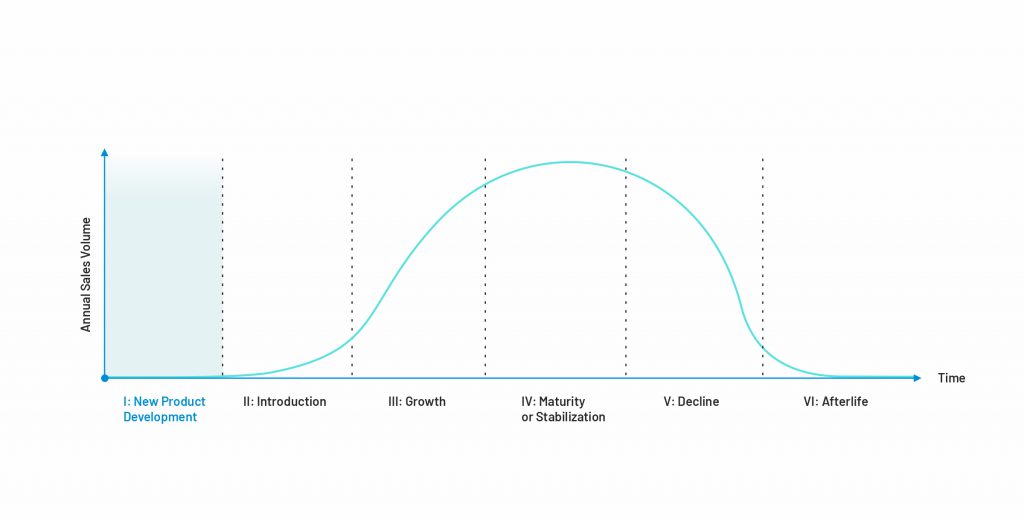
The new product development stage is a period between the emergence of the idea and the introduction of the product to the public. For a startup, it is the most stressful and resource-demanding period that starts with the selection of a vendor that provides product development services.
One of the best ways to allocate your development resources with maximum efficiency is to stick to the Lean development approach. Lean development allows you to iteratively release product version by version and feature by feature ensuring its necessary for users.
The Lean product development cycle at Railsware includes six stages:
- Ideation & Discovery. After precise data collection, market research, competitor analysis, surveys, etc., goes a 2-day BRIDGeS session. During the session, we evaluate a product idea, ensure its viability, and maximize the chances of reaching a product-market fit.
- Prototyping & Validation. We promptly create small solutions to test them with real users and get feedback. This way we test product hypotheses, collect insights, and make a list of improvements that lay the foundation for the product roadmap.
- Initial development. We think through the tech stack, architecture, databases, tools, and product design skeletons to build a solid base for a future product.
- Alpha and Beta stages are focused on close interaction with first users, their onboarding, and feedback gathering. At this phase, we use various marketing approaches (CustDev, surveys, research, etc.) to see if potential customers are excited about your solution, or if it needs refinement. We also decide what actionable startup metrics we’ll be tracking and create a product dashboard for the future.
- MVP development and release. From the previous stages, we got a basic solution that we now improve, polish, add some other crucial features, and release to the masses. With the end-to-end analytics that we set up earlier, we can easily monitor slight changes in product performance and timely react to them.
- Growing product. We use analytical data, gathered customer feedback, and research results to build new product hypotheses, verify them with BRIDGeS, and repeat the cycle.
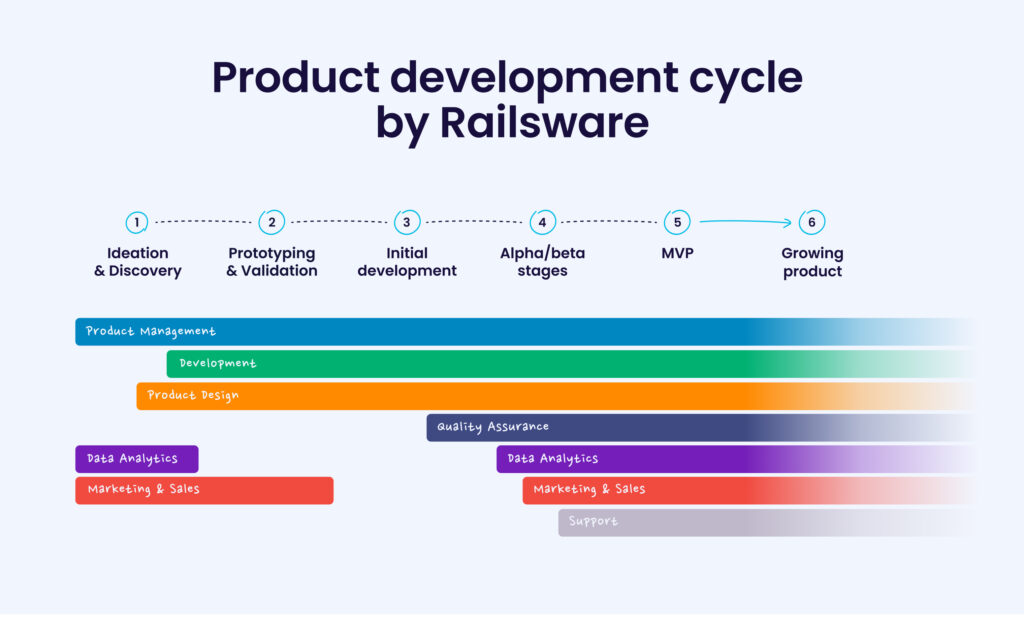
Press on the banner below, if you want to know how we use the flexible framework BRIDGeS to investigate product-related context, identify hidden risks and opportunities, test the feasibility of your product idea, and set up an actionable development plan for the MVP, prototype, or PoC.
Note that MVP, prototype, and PoC, although commonly used interchangeably, are not the same thing. We’ve taken the time to explain the MVP vs prototype vs PoC topic in a separate article, so feel free to check that out on our blog.
Classic view on the product life cycle stages
The introductory stage
The classic product life cycle starts with the introductory stage which implies putting an existing working product in front of users. However, our team prefers to test ideas before investing in their development. Usually, we start marketing solutions way before they are ready, to check if there’s interest in them.
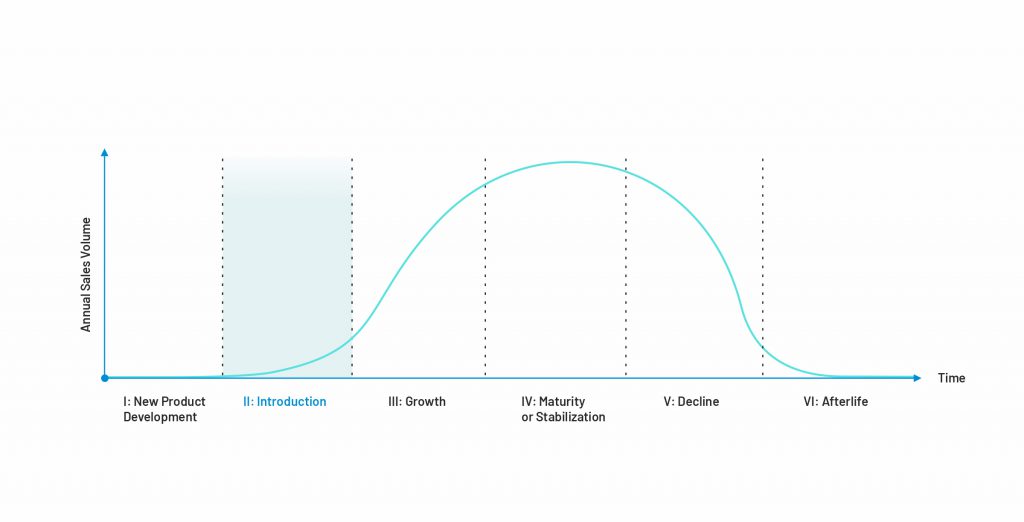
To start penetrating the market you don’t need a complete product. At this point, you can:
- build the community around your future brand;
- expand your audience in social media;
- create a landing page using landing page creators for your solution with a waitlist;
- start talking about your product at conferences and not only;
- create as much content around your products as possible.
When the Alpha and Beta versions of your solution are ready, you can start onboarding those, who showed interest in it. Aim at innovators and early adopters who would serve as your key endorsers. Gather users’ feedback, analyze it, and prioritize product improvements based on data.
With an MVP ready, establish your distribution tactics – it may be selective, aimed at a specific niche, or flooding, offering trials, and discounts. Decide on the price – it may be higher to cover the initial expenses or lower to gain the market share. Take care of intellectual property rights.
The duration of the stage heavily depends on the product itself. The key to success is demand. The higher the need for your product is, the faster it will transition from the introductory stage to the growth stage. You can have a fantastic and working idea, but if no one needs your product, you are in trouble. For instance, if you’re working on a secure video call app during a pandemic lockdown, it will immediately skyrocket to the growth stage and conquer the market (we’ve seen that before). However, if your product is another Uber in New York, it has a long way ahead and may never make it at all.
If your product feels familiar and straightforward, it will be easier to spread it to the masses, but it is likely to face more competition. On the other hand, if you have a complex, utterly novel product that is not entirely intuitive and requires some additional skills, it will take more time to proliferate in the market.
The introductory stage is the riskiest one as the hazards are not always obvious and could kill the product at the very beginning. Besides, at this phase, be ready to deal with:
- low profits as the number of your customers is small;
- slow sales and gradual development of the client base;
- little or no competition if you are the first to take the niche;
- high budget for marketing and promotion;
- time-consuming education of the customers.
The growth stage
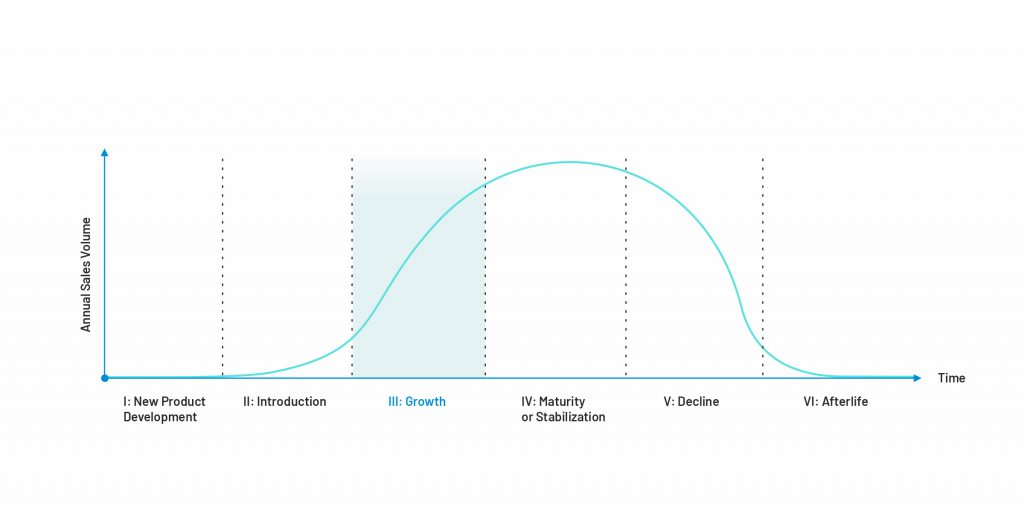
If everything goes well, after the initial introduction, a product starts gaining users and bringing profit. The growth stage is the time when you obtain the most profit. It is likely to increase rapidly and reach its peak before the maturity stage. During this period, you have a growing customer base without large marketing efforts, your brand awareness expands, customers gladly recommend your solution to others, and the demand multiplies. This is what we call a product-market fit. Even if your product is not expensive, the boom in sales and the active flow of new clients bring you high profits.
At the growth stage, you need to:
- make sure your product works smoothly so that your new clients get what they expect;
- stick to a stable price policy;
- continue investing in marketing to reinforce your brand message and make your users loyal;
- think of the most efficient distribution channels to guarantee product availability;
- add new features and improve the design to expand the presence on the market.
Even though the competition is still low, the first rivals appear. They watched your success and may offer almost the same product as you do, but slightly different – for instance, their marketplace offers more search options, detailed catalogs, and better inventory options. That is why, at the growth stage, you need to make your brand distinguished and gain the loyalty of customers, especially those who would endorse your product. By the end of this phase, the number of competitors grows, and you face the need to protect and hold your position.
The maturity stage
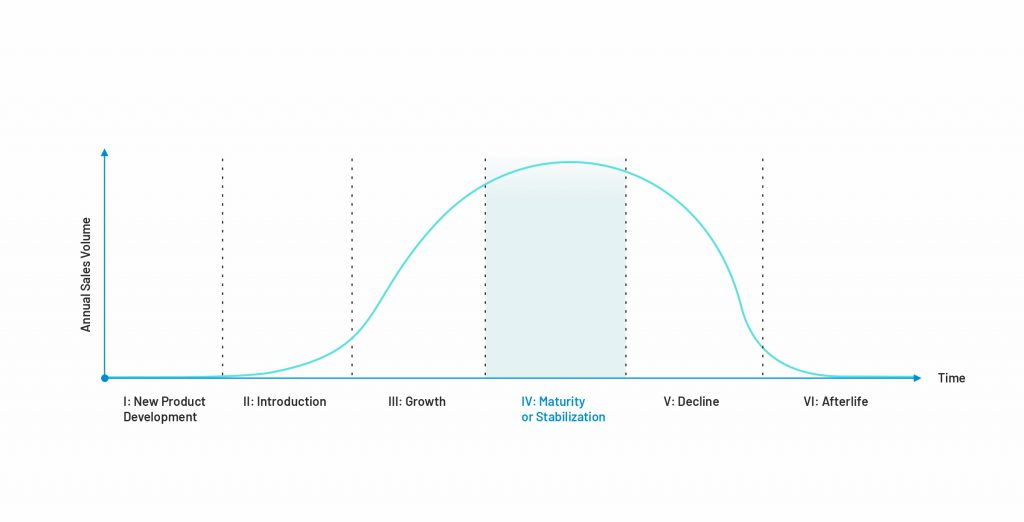
After rapid growth, a product is likely to enter a phase of steady existence. The maturity stage is also known as the phase of stabilization and saturation. This is the time when your sales hit a peak – the majority of your potential clients already use your product, meaning there’s no more space to grow. Now, you have to come up with new offers to compete with rivals. Those of your competitors that entered the market at your growth stage have now reached their own. And while you are thinking about how to keep your position and hold the market share, they enjoy the growth phase, benefiting from your niche.
In order not to lose what you have achieved, at the maturity stage, you should:
- enhance features to distinguish your product from competitors;
- think of improvements to offer something stunning that has not yet come to the minds of your rivals;
- explore new markets and expand the distribution networks to gain more customers;
- lower prices to maintain the client base and prevent them from switching to competitors;
- allocate your resources to marketing.
The price drop is almost inevitable. Even if you do not have any strong competitors, your customer base is already saturated, and it will not bring you as much profit as it did before. To prevent profit from dropping, you need new users and new niches.
The maturity stage does not have a definite time frame: it may last for decades. Some products remain at this phase as there are no reasonable substitutes (Android and iOS), and some have achieved the status of a classic (Uber, AirBnB). If your product does not have such a promising potential, there is not that much you can do to prolong the maturity stage. The only thing to prolong the life cycle and prevent your product from falling into oblivion is to create conditions for more frequent and varied use of the product.
The decline stage
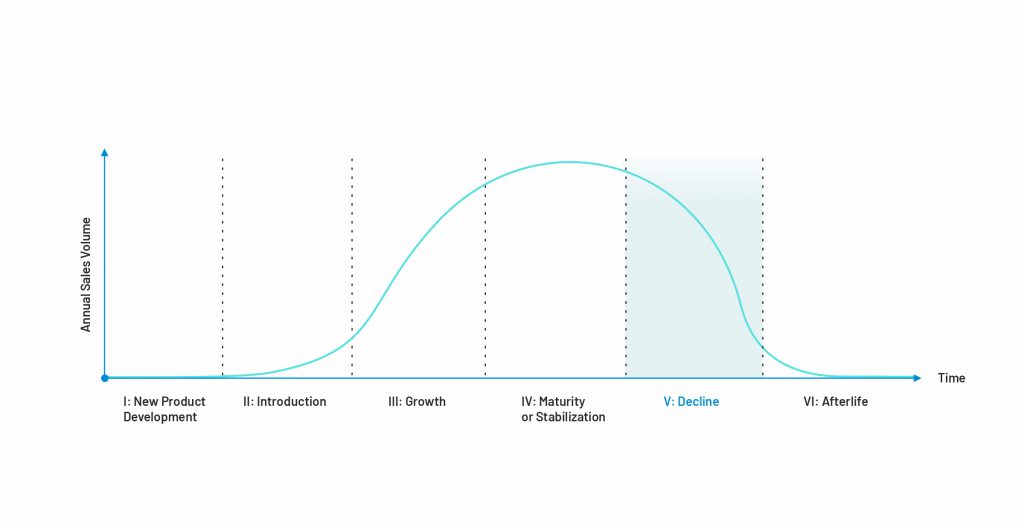
Sooner or later, the maturity stage ends with the decline. It will not happen at the click of a finger, but, eventually, you will notice a steady, gradual decrease in your sales and profits. Usual marketing tricks and technical improvements will not help – they may only slow down the decline.
At this phase, you need to have the guts to:
- deal with the competition that escalates;
- acknowledge the reality of lost customers to a newer, better alternative product;
- drop down the prices as low as possible to maintain your client base;
- work on an alternative product, the one to substitute the current product but transformed and improved in a way to be competitive and attractive;
- radically change the target audience in the hope of reviving the interest.
Even after doing your best and jumping over the head, your product may not be among those capable of surviving the competition. In such a case, stopping production and discontinuing the product could be the best choice.
Product’s afterlife scenarios
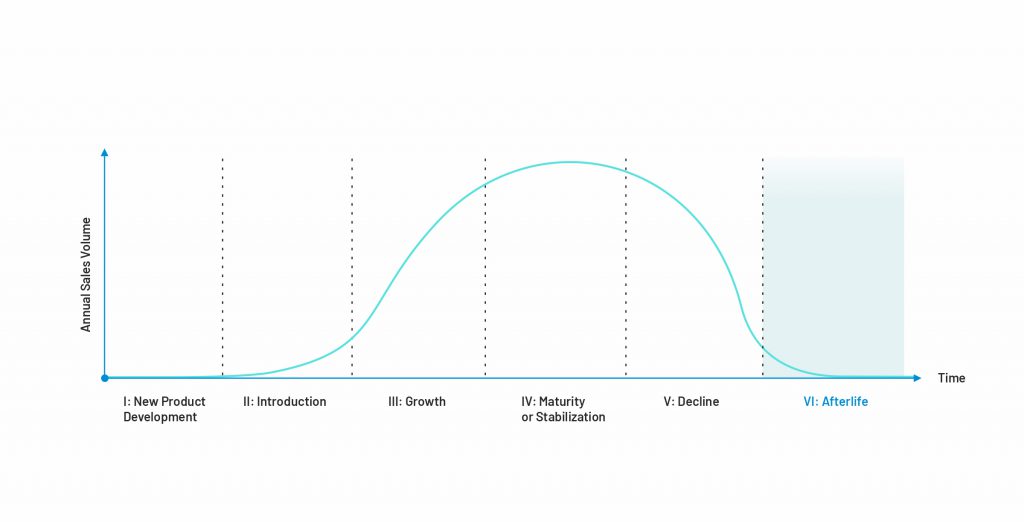
Often the decline stage means a slow death of a product and its dive into oblivion. However, occasionally, the end of the life cycle is not as pathetic and doomed. Let’s cover several possible scenarios a product could take a role in after its life is over.
1. Gradual or immediate death
Some products no longer have any use. They have performed their function and are completely outdated. Harsh competition, advanced technology, new scientific discoveries, a shift in values, and plenty of other reasons may make a product useless and not in demand.
2. Hereditary through transformation
A product may be useless as it is at the time of decline, but, with certain transformations, it could come back to life.
In such cases, companies take a dying product as a base and reboot it, changing its direction drastically. A good example is Netflix which used to rent DVDs by mail but later switched to video streaming when the internet bloomed, PCs got cheaper, and DVD players became obsolete. Another example is Amazon which was selling only books but had to evolve into a marketplace for all sorts of goods.
Thus, it is no longer an old version of the product, but a base for a new one that transmits its genes and enables the emergence of the next generation.
3. Inspiration (positive or negative)
The most honorable outcome for a product is to become an inspiration for a new one. Inspiration is always a part of the hereditary process, but it can also be a separate case – for instance, when a gone product serves as a muse for products in different industries.
However, inspiration does not necessarily have to be positive. A product may serve as a warning, inspire startups to do everything differently, and stop them from incorporating the product’s flaws – design, legal issues, technologies, etc.
4. Relic
When a product is no longer available in the market, it may become a relic, a valuable item for true fans. It may serve as a nostalgic marker of a cultural epoch, phenomenon, or event, or be used in movies or art installations. Like a video game from youth. From an economic point of view, it does not bring any profit to its creators, but, as an object, it may continue its life cycle.
5. Resurrection
Long gone and forgotten products may revive, come back from oblivion, and start their life cycle all over again. Usually, they are modernized and brought into accordance with the up-to-date customer requirements and values. Resurrection differs from the hereditary stage in terms of time: hereditary is smooth, sequential in time, following the initial product, while resurrection means the revival of a product that left the market years or decades ago.
Guidelines to spot a product’s life phase
In the table below, we aggregated all the basics regarding each stage. Keep in mind that, depending on the product, they may vary. Also, in the table, there is no afterlife stage as the scenarios are way too unique and specific in each case.
Product development life cycle overview
| Development | Introduction | Growth | Maturity | Decline | |
|---|---|---|---|---|---|
| Product's evolution | Initial idea Working prototype First onboarded users | Initial working product | Perfection of the features to build up a solid product image | Additional features and supplementary products to distinguish from competitors | Major product transformation or a complete redesign |
| Customers | None | Innovators | Early adopters | Mass market | Loyal users Low-price hunters |
| Marketing strategy | Market research Buzz | Brand building Buzz | Gaining loyalty Reinforcement of the brand message | Intense promotion Market expansion Fight for the customers | Keeping the loyal (e.g. with discounts, new offers) |
| Purpose | Creation of valuable, working product | Building demand and customer base Cost-effective production | Gaining market share and establishing positions Reduction of manufacturing cost | Maitainance the market share Outliving the competition | Exiting the game with dignity |
| Indicators | |||||
| - sales | none | low | high | maximum | low |
| - profit | none | low | maximum | high | low |
| - investments | maximum | high | high | low | low |
| - competition | none | low | medium | high | maximum |
| Exit criteria | The product is ready to enter the market | The profit and sales levels start to grow rapidly | The profit level stabilizes | The profit and sales levels start to decline | The product is no longer economically viable |
| Benefits | Opportunity to create its own niche and demand for the product | Almost no competition High price and growing profit | Lower production costs Higher consumer awareness High profit | Further reduction of the production costs | Cheap production Opening new markets |
| Challenges | High resource demand (time, effort, money) | No market and low sales First products are expensive | Increasing competition Need to lower prices | Intense competition Profit decline Need to think of product improvements and new markets | Low profit and sales Need to withdraw the product |
Factors to disrupt a smooth life cycle
The stages discussed above mirror milestones a product passes through on its life cycle. Their duration is hard to predict, and the borders between phases are blurry. Besides, at any stage, a set of unexpected factors may emerge and affect a product’s life cycle. Usually, these issues are out of your control, and, for this reason, they are of great danger.
The factors to intrude into a product life cycle are endless, and we will list only a few of them:
Running out of money
Inappropriate resource allocation, overhiring, poor planning, intuition-driven decisions, and no data collection – all these are the reasons why your startup can run out of money. Another common issue is the termination of funding or, in case you planned to reinvest income back into the product, – poor cash flow.
Customer acquisition cost is too high
Too expensive CAC can eat all your budget, leaving no resources for other critical things. The most common reasons for costly CAC are improper targeting, little to no marketing, or, vice versa, too much marketing effort.
Targeting the wrong audience
Startups that don’t have a very tight connection with the targeted audience tend to rely on their gut feeling instead of real data. As a young startup, you should be ready to change the target audience if the primary market showed no interest in your solution. And to do that, regular interaction with potential users is a must.
Fierce competition
When entering a highly competitive market, a startup should offer something that competitors don’t have but that users crave. If this unique feature doesn’t solve a large problem and satisfy underserved customer needs, users would stay with your competitor – a more mature product they are used to.
Wrong monetization plan
It’s not easy to come up with a working monetization strategy that would allow you to cover your expenses, make a profit, and stay competitive. Charging too low is as bad as charging too high. Both options lead to low income and product death.
Real-life product life cycle
Now it’s time to see what it all looks like in real life.
Calendly life cycle
The development stage for Calendly started in January 2014 when Tope Awotona, Calendly founder and CEO reached out to the Railsware team. An experienced entrepreneur, Tope was looking for an effective solution for sales managers to avoid back and force emailing.
The Calendly founder had an in-depth understanding of the niche and a lot of data carefully gathered before the meeting. He shared all the information and in a 2-day BRIDGeS session, we sorted it all out, analyzed it with different specialists, detected hidden pitfalls, and created a plan for the first product release. To save resources and launch the product fast, the scope included the development of a Google Calendar add-on with a simple interface.
When the working prototype was ready, the team introduced it to a limited number of our clients who struggled with making appointments. First users were carefully onboarded one by one, their impressions collected and processed. As the product was easy to use and it efficiently solved serious pain, users told their colleagues and friends about it and fast enough the product went viral.
The user base started growing rapidly and demanded new functionality. During the next releases, the product was integrated with other calendars like Microsoft Exchange, Outlook, Office365, etc.
Today, Calendly is a $3 billion company with dozens of 3rd party integrations and millions of users worldwide. According to the parameters listed above, now the product is in the stage of maternity that, we hope, will last for many decades.
Final remarks
The product life cycle, with all its stages, characteristics, benefits, and challenges, is a helpful conceptual frame. It gives relief and makes the unknown comprehensible. Although you can’t predict exactly what will happen to your creation, you have an outline of how things should go in the ideal scenario. You may plan your product marketing strategies for the maturity and decline stages, think of the hazards and risk factors that may intervene in the cycle, and come up with a plan B.
There are zero guarantees that your product will go from stage to stage, fulfilling all the expectations and following the prescribed changes in indicators. But, like any other conceptual frame, the product life cycle is there for you to create a sense of control over the process. It costs you nothing to apply it while dreaming of your product’s future. And, perhaps, it will serve you as a shield from the unexpected.

